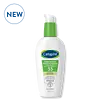What's inside
What's inside
 Key Ingredients
Key Ingredients

 Benefits
Benefits

 Concerns
Concerns

 Ingredients Side-by-side
Ingredients Side-by-side

Water
Skin ConditioningAzelaic Acid
BufferingPropylene Glycol
HumectantGlycerin
HumectantAloe Barbadensis Leaf Juice
Skin ConditioningSqualane
EmollientPropanediol
SolventSodium Acrylate/Sodium Acryloyldimethyl Taurate Copolymer
Emulsion StabilisingC15-19 Alkane
SolventTocopheryl Acetate
AntioxidantPolyglyceryl-6 Laurate
EmulsifyingPolyglycerin-6
HumectantSorbitan Olivate
EmulsifyingSorbitan Isostearate
EmulsifyingPhenoxyethanol
PreservativeEthylhexylglycerin
Skin ConditioningPotassium Sorbate
PreservativeSodium Benzoate
MaskingWater, Azelaic Acid, Propylene Glycol, Glycerin, Aloe Barbadensis Leaf Juice, Squalane, Propanediol, Sodium Acrylate/Sodium Acryloyldimethyl Taurate Copolymer, C15-19 Alkane, Tocopheryl Acetate, Polyglyceryl-6 Laurate, Polyglycerin-6, Sorbitan Olivate, Sorbitan Isostearate, Phenoxyethanol, Ethylhexylglycerin, Potassium Sorbate, Sodium Benzoate
Butyl Methoxydibenzoylmethane 2.8%
UV AbsorberHomosalate 9.5%
Skin ConditioningEthylhexyl Salicylate 4.8%
UV AbsorberOctocrylene 7%
UV AbsorberWater
Skin ConditioningGlycerin
HumectantDipropylene Glycol
HumectantPanthenol
Skin ConditioningEthylhexyl Methoxycrylene
Skin ConditioningIsopropyl Palmitate
EmollientSilica
AbrasiveNiacinamide
SmoothingCetearyl Olivate
Cetearyl Alcohol
EmollientGlyceryl Stearate
EmollientPotassium Cetyl Phosphate
EmulsifyingSorbitan Olivate
EmulsifyingTocopheryl Acetate
AntioxidantCaprylyl Glycol
EmollientAcrylates/C10-30 Alkyl Acrylate Crosspolymer
Emulsion StabilisingPalmitic Acid
EmollientEthylhexylglycerin
Skin ConditioningLeontopodium Alpinum Extract
Skin ConditioningStearic Acid
Cleansing1,2-Hexanediol
Skin ConditioningOryza Sativa Lees Extract
Skin ConditioningPropanediol
SolventSodium Hydroxide
BufferingAdenosine
Skin ConditioningPotassium Sorbate
PreservativeSodium Benzoate
MaskingCitric Acid
BufferingMyristic Acid
CleansingBuddleja Davidii Leaf Extract
Skin ConditioningThymus Vulgaris Leaf Extract
Skin ProtectingTocopherol
AntioxidantButyl Methoxydibenzoylmethane 2.8%, Homosalate 9.5%, Ethylhexyl Salicylate 4.8%, Octocrylene 7%, Water, Glycerin, Dipropylene Glycol, Panthenol, Ethylhexyl Methoxycrylene, Isopropyl Palmitate, Silica, Niacinamide, Cetearyl Olivate, Cetearyl Alcohol, Glyceryl Stearate, Potassium Cetyl Phosphate, Sorbitan Olivate, Tocopheryl Acetate, Caprylyl Glycol, Acrylates/C10-30 Alkyl Acrylate Crosspolymer, Palmitic Acid, Ethylhexylglycerin, Leontopodium Alpinum Extract, Stearic Acid, 1,2-Hexanediol, Oryza Sativa Lees Extract, Propanediol, Sodium Hydroxide, Adenosine, Potassium Sorbate, Sodium Benzoate, Citric Acid, Myristic Acid, Buddleja Davidii Leaf Extract, Thymus Vulgaris Leaf Extract, Tocopherol
 Reviews
Reviews

Ingredients Explained
These ingredients are found in both products.
Ingredients higher up in an ingredient list are typically present in a larger amount.
Ethylhexylglycerin (we can't pronounce this either) is commonly used as a preservative and skin softener. It is derived from glyceryl.
You might see Ethylhexylglycerin often paired with other preservatives such as phenoxyethanol. Ethylhexylglycerin has been found to increase the effectiveness of these other preservatives.
Glycerin is already naturally found in your skin. It helps moisturize and protect your skin.
A study from 2016 found glycerin to be more effective as a humectant than AHAs and hyaluronic acid.
As a humectant, it helps the skin stay hydrated by pulling moisture to your skin. The low molecular weight of glycerin allows it to pull moisture into the deeper layers of your skin.
Hydrated skin improves your skin barrier; Your skin barrier helps protect against irritants and bacteria.
Glycerin has also been found to have antimicrobial and antiviral properties. Due to these properties, glycerin is often used in wound and burn treatments.
In cosmetics, glycerin is usually derived from plants such as soybean or palm. However, it can also be sourced from animals, such as tallow or animal fat.
This ingredient is organic, colorless, odorless, and non-toxic.
Glycerin is the name for this ingredient in American English. British English uses Glycerol/Glycerine.
Learn more about GlycerinPotassium Sorbate is a preservative used to prevent yeast and mold in products. It is commonly found in both cosmetic and food products.
This ingredient comes from potassium salt derived from sorbic acid. Sorbic acid is a natural antibiotic and effective against fungus.
Both potassium sorbate and sorbic acid can be found in baked goods, cheeses, dried meats, dried fruit, ice cream, pickles, wine, yogurt, and more.
You'll often find this ingredient used with other preservatives.
Learn more about Potassium SorbatePropanediol is an all-star ingredient. It softens, hydrates, and smooths the skin.
It’s often used to:
Propanediol is not likely to cause sensitivity and considered safe to use. It is derived from corn or petroleum with a clear color and no scent.
Learn more about PropanediolSodium Benzoate is a preservative. It's used in both cosmetic and food products to inhibit the growth of mold and bacteria. It is typically produced synthetically.
Both the US FDA and EU Health Committee have approved the use of sodium benzoate. In the US, levels of 0.1% (of the total product) are allowed.
Sodium benzoate works as a preservative by inhibiting the growth of bacteria inside of cells. It prevents the cell from fermenting a type of sugar using an enzyme called phosphofructokinase.
It is the salt of benzoic acid. Foods containing sodium benzoate include soda, salad dressings, condiments, fruit juices, wines, and snack foods.
Studies for using ascorbic acid and sodium benzoate in cosmetics are lacking, especially in skincare routines with multiple steps.
We always recommend speaking with a professional, such as a dermatologist, if you have any concerns.
Learn more about Sodium BenzoateSorbitan Olivate is created from the fatty acids in olive oil and sorbitol.
This ingredient is an oil in water emulsifier. It helps stabilize a product by preventing oils and waters from separating. Sorbitan Olivate also helps hydrate the skin.
Manufacturers sell sorbitan olivate under the name OliveM 1000. OliveM 1000 a multifunctional ingredient. It is self-emulsifying. According to a manufacturer, OliveM 1000 does not disrupt natural skin biome.
Due to its olive oil base, this ingredient may not be fungal-acne safe.
Learn more about Sorbitan OlivateTocopheryl Acetate is AKA Vitamin E. It is an antioxidant and protects your skin from free radicals. Free radicals damage the skin by breaking down collagen.
One study found using Tocopheryl Acetate with Vitamin C decreased the number of sunburned cells.
Tocopheryl Acetate is commonly found in both skincare and dietary supplements.
Learn more about Tocopheryl AcetateWater. It's the most common cosmetic ingredient of all. You'll usually see it at the top of ingredient lists, meaning that it makes up the largest part of the product.
So why is it so popular? Water most often acts as a solvent - this means that it helps dissolve other ingredients into the formulation.
You'll also recognize water as that liquid we all need to stay alive. If you see this, drink a glass of water. Stay hydrated!
Learn more about Water